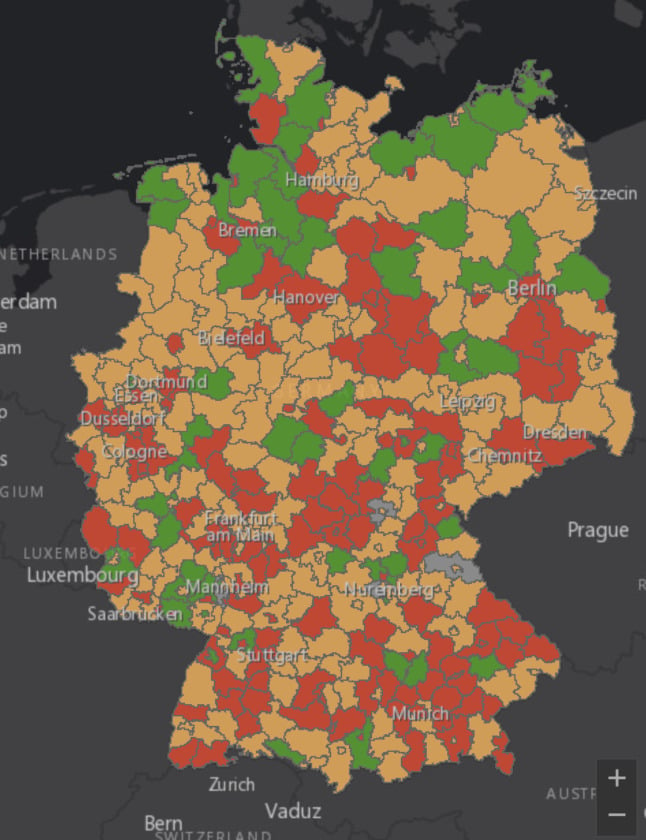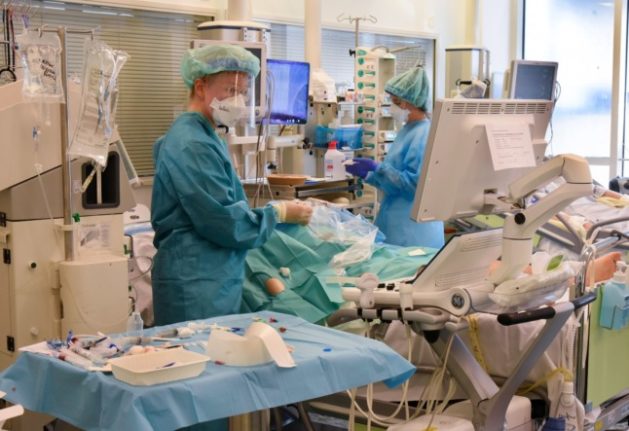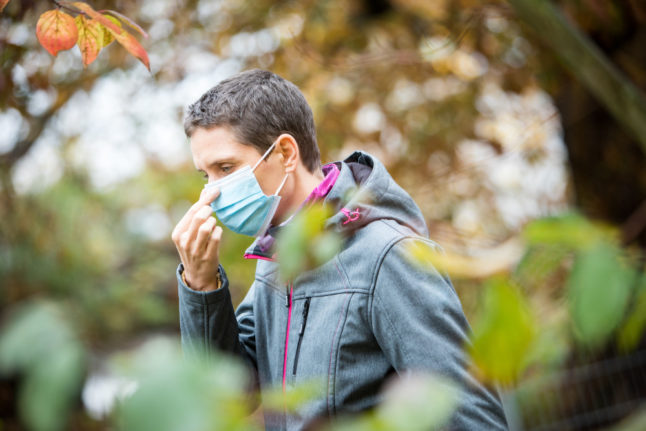German hospitals and medics are struggling due to the number of Covid-19 patients needing treatment.
Some intensive care units are already full, while other hospitals are having to cancel planned operations in order to divert staff to critical wards.
The latest data shows about 14 percent of intensive care beds are still available nationwide. And in 33 districts not a single bed is free. In some regions, more than 50 percent of the beds in ICUs are occupied by Covid-19 patients, illustrating why medical staff have been raising the alarm.
The DIVI intensive care register reported about 3,280 Covid 19 patients in intensive care units across Germany on Monday. This makes up around 15 percent of the occupied ICU beds.
For comparison, around 1,768 Covid-19 patients were in intensive care wards across Germany on October 27th.
Of the Covid patients in German ICUs, just over 50 percent require ventilation treatment.
The nationwide hospitalisation incidence stands at 4.96 Covid patients per 100,000 people. The highest hospitalisation incidence was around 15.5 and was recorded in the second wave in Christmas time last year.
Most of the districts where intensive care beds are running out are in Bavaria, which declared a state of emergency last week and has tightened its Covid rules to try and control the spread.
READ ALSO: 2G rules – How Bavaria is tightening restrictions on the unvaccinated

Medical experts have been warning that patients in some ares are at times having to wait for hours to receive treatment, or have to try another hospital.
SPD health politician Karl Lauterbach said he predicted that in the coming weeks people will have to be flown by helicopter to other federal states to receive intensive care treatment.
“With the number of cases we have at the moment, hospitals across the country will reach capacity in the first two weeks of December,” Lauterbach said.
In total, around 21,344 of the 24,796 intensive care beds in Germany are currently occupied.
According to the DIVI register, these are the districts in Germany that do not have any free intensive care beds:
Aichach-Friedberg district (Bavaria)
Occupied beds: 100 percent – 13 out of 13
Covid patients: 38.5 percent – 5
of which are ventilated: 4
Alzey-Worms (Rhineland-Palatinate)
Occupied beds: 100 percent – 7 out of 7
Covid patients: 0 percent – 0
Augsburg (Bavaria)
Occupied beds: 100 percent – 12 of 12
Covid patients: 66.7 percent – 8
Of which are ventilated: 2
Berchtesgadener Land district (Bavaria)
Occupied beds: 100 percent – 18 of 18
Covid patients: 22.2 percent – 4
Of which are ventilated: 3
Biberach (Baden-Württemberg)
Occupied beds: 100 percent – 16 of 16
Covid patients: 31.3 percent – 5
Of which are ventilated: 3
Cham (Bavaria)
Occupied beds: 100 percent – 15 of 15
Covid patients: 66.7 percent – 10
Of which are ventilated: 5
Dachau (Bavaria)
Occupied beds: 100 per cent – 18 of 18
Covid patients: 22.2 per cent – 4
Of which are ventilated: 3
Darmstadt-Dieburg (Hesse)
Occupied beds: 100 percent – 26 of 26
Covid patients: 38.5 percent – 10
Of which are ventilated: 8
Dillingen an der Donau (Bavaria)
Occupied beds: 100 percent – 27 of 27
Covid patients: 37 percent – 10
Of which are ventilated: 4
Ebersberg (Bavaria)
Occupied beds: 100 percent – 18 of 18
Covid patients: 33.3 percent – 6
Of which are ventilated: 2
City district Frankfurt (Oder)
Occupied beds: 100 percent – 12 of 12
Covid patients: 41.7 percent – 5
Of which are ventilated: 3
Freudenstadt (Baden-Württemberg)
Occupied beds: 100 percent – 6 of 6
Covid patients: 33.3 percent – 2
Of which are ventilated: 0
Fürstenfeldbruck (Bavaria)
Occupied beds: 100 percent – 10 out of 10
Covid patients: 50 percent – 5
Of which are ventilated: 4
City district of Gera (Thuringia)
Occupied beds: 100 percent – 44 out of 44
Covid patients: 38.6 percent – 17
Of which are ventilated: 5
Gifhorn (Lower Saxony)
Occupied beds: 100 percent – 12 of 12
Covid patients: 33.3 percent – 4
Of which are ventilated: 3
Greiz (Thuringia)
Occupied beds: 100 per cent – 10 out of 10
Covid patients: 30 per cent – 3
Of which are ventilated: 2
Kelheim (Bavaria)
Occupied beds: 100 percent – 14 out of 14
Covid patients: 50 percent – 7
Of which are ventilated: 2
Kitzingen (Bavaria)
Occupied beds: 100 percent – 8 of 8
Covid patients: 37.5 percent – 3
Of which are ventilated: 0
Haßberge (Bavaria)
Occupied beds: 100 percent – 6 of 6
Covid patients: 66.7 percent – 4
Of which are ventilated: 1
Hildburghausen (Thuringia)
Occupied beds: 100 percent – 6 of 6
Covid patients: 66.7 percent – 4
Of which are ventilated: 4
Hochtaunuskreis district (Hesse)
Occupied beds: 100 percent – 24 of 24
Covid patients: 16.7 percent – 4
Of which are ventilated: 3
Lüchow-Dannenberg (Lower Saxony)
Occupied beds: 100 percent – 7 of 7
Covid patients: 28.6 percent – 2
Of which are ventilated: 2
Mainz-Bingen (Rhineland-Palatinate)
Occupied beds: 100 percent – 12 of 12
Covid patients: 8.3 percent – 1
Of which are ventilated: 0
Neumarkt in der Oberpfalz (Bavaria)
Occupied beds: 100 percent – 22 of 22
Covid patients: 40.9 percent – 9
Of which are ventilated: 5
Osterholz (Lower Saxony)
Occupied beds: 100 percent – 10 out of 10
Covid patients: 30 percent – 3
Of which are ventilated: 2
Rastatt (Bavaria)
Occupied beds: 100 percent – 10 out of 10
Covid patients: 0 percent – 0
Saale-Orla (Thuringia)
Occupied beds: 100 percent – 3 of 3
Covid patients: 0 percent – 0
Schwabach (Bavaria)
Occupied beds: 100 percent – 5 of 5
Covid patients: 40.0 percent – 2
Of which are ventilated: 0
Sömmerda (Thuringia)
Occupied beds: 100 percent – 4 out of 4
Covid patients: 25 percent – 1
Of which are ventilated: 1
Unterallgäu (Bavaria)
Occupied beds: 100 percent – 14 of 14
Covid patients: 57.1 percent – 8
Of which are ventilated: 5
Neu-Ulm (Bavaria)
Occupied beds: 100 percent – 18 of 18
Covid patients: 44.4 percent – 8
Of which are ventilated: 2
Waldshut (Baden-Württemberg)
Occupied beds: 100 percent – 10 out of 10
Covid patients: 20 percent – 2
Of which are ventilated: 1
Wittmund (Lower Saxony)
Occupied beds: 100 percent – 8 out of 8
Covid patients: 0 percent – 0
Please keep in mind that these figures can change rapidly.



 Please whitelist us to continue reading.
Please whitelist us to continue reading.
Please tell us what age groups and whether or not vaccinated are occupying the ICUs